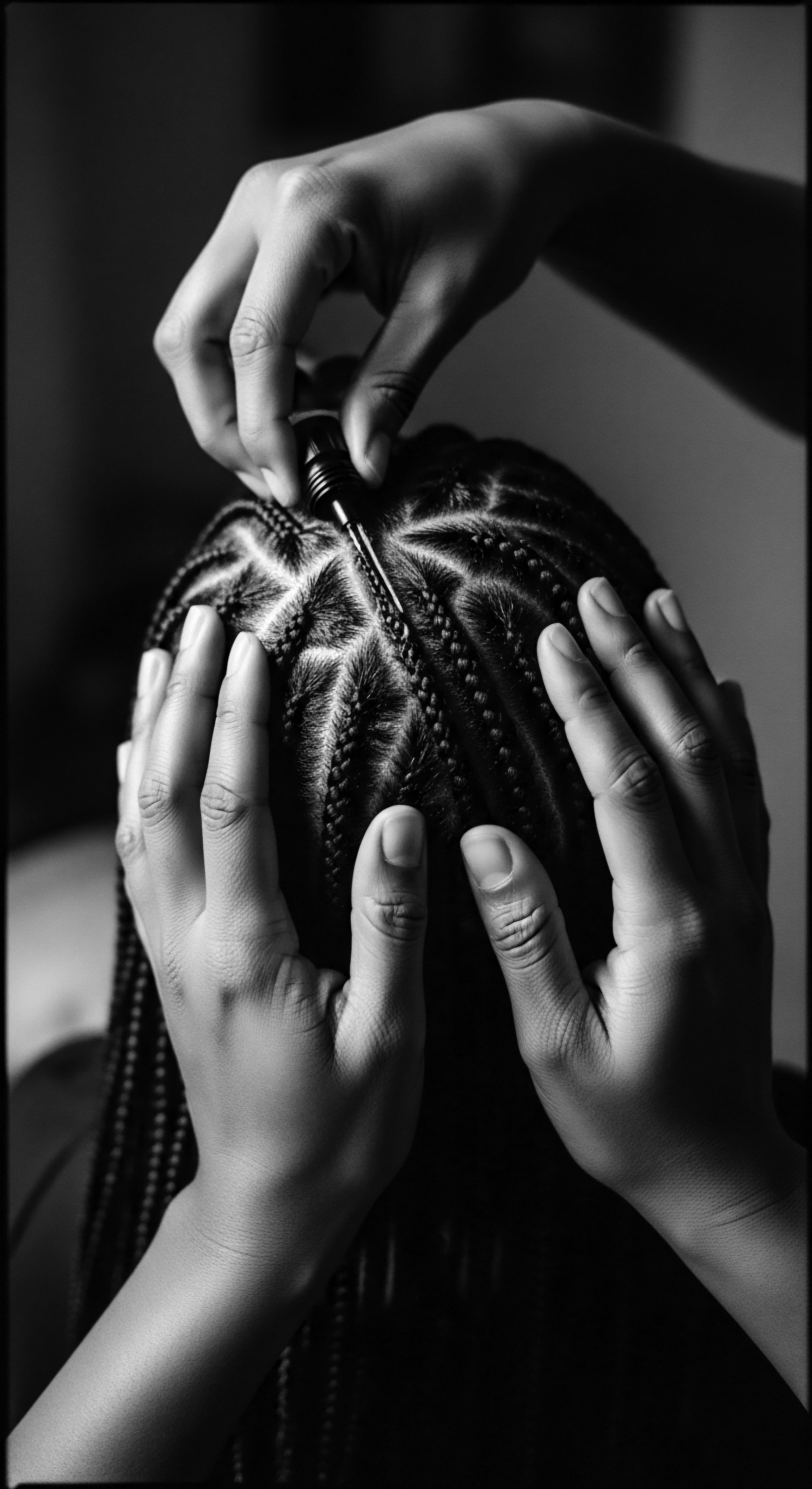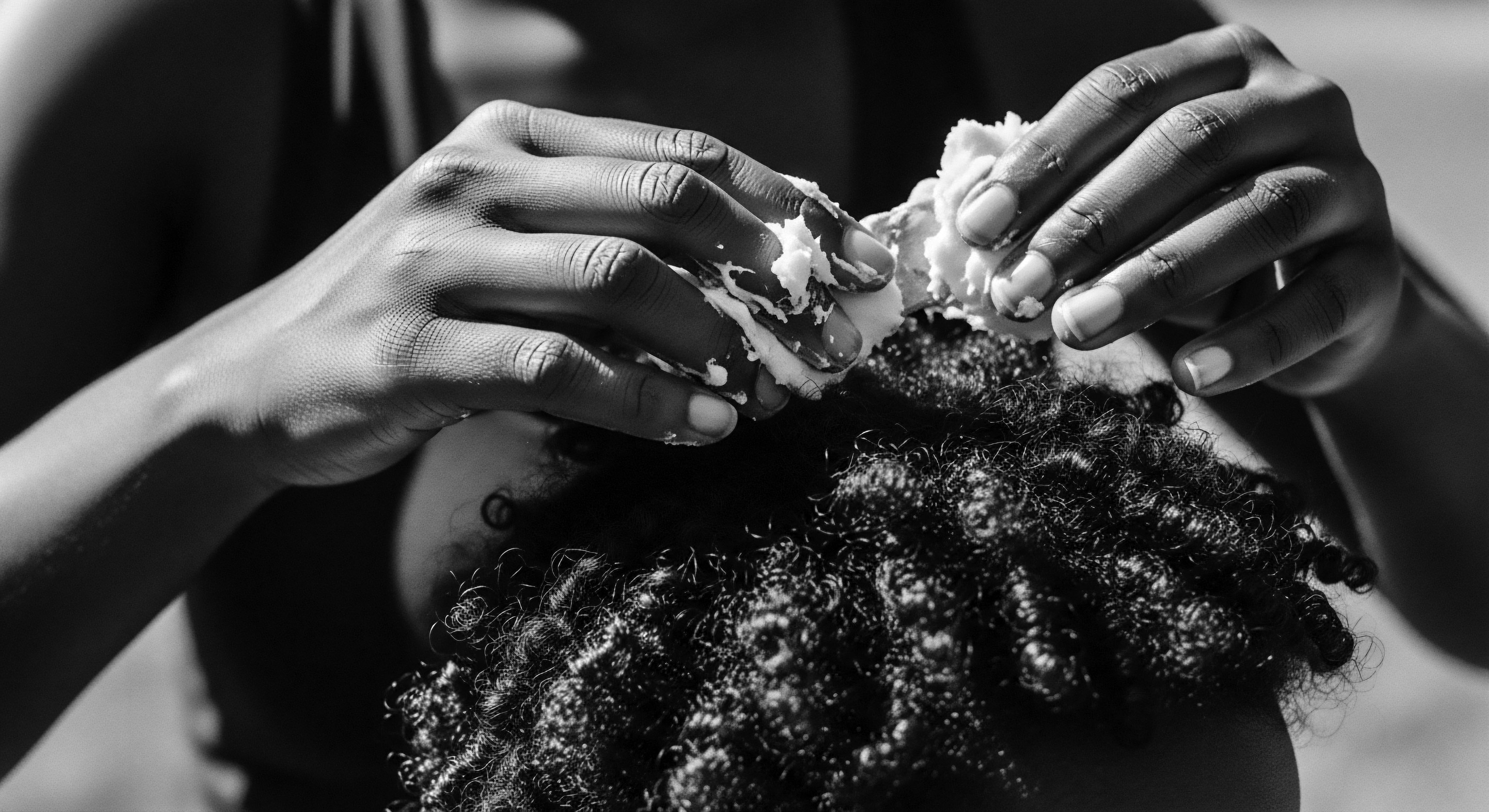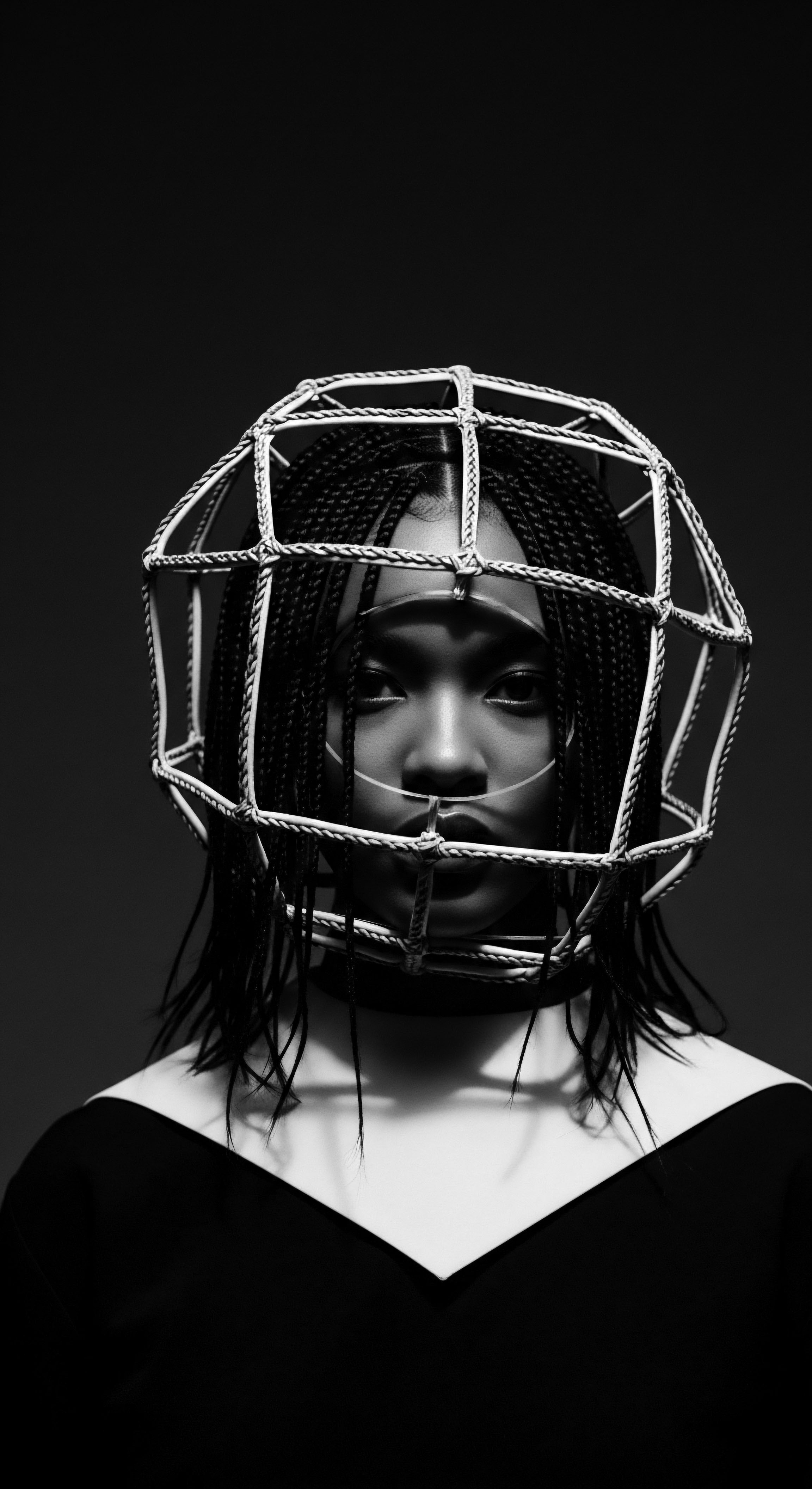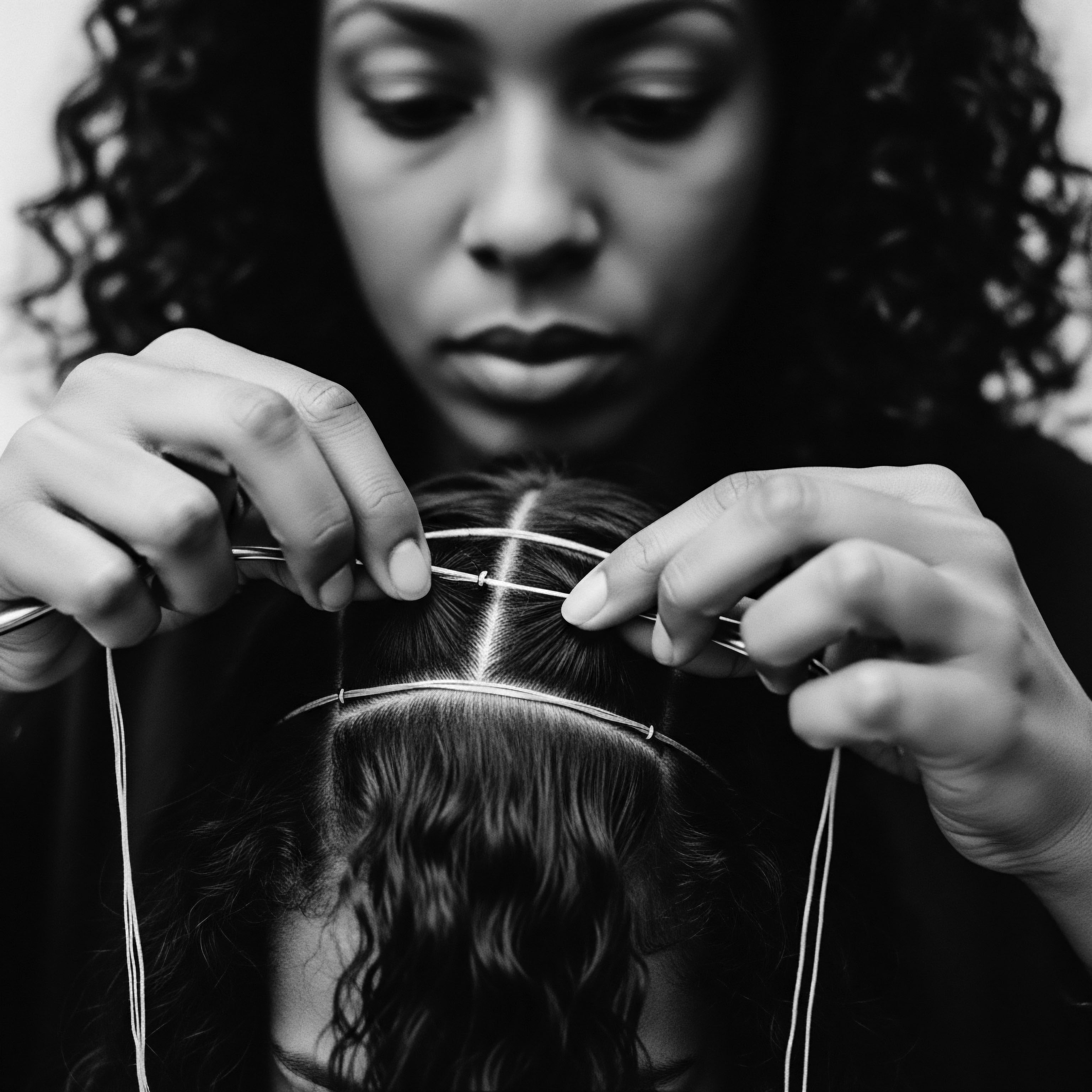
Fundamentals
The concept of Nighttime Hair, at its core, speaks to the mindful and often ancestral practice of safeguarding one’s hair during hours of rest. This fundamental approach recognizes that sleep, a period of deep physiological restoration for the body, also presents unique challenges and opportunities for hair health, particularly for textured hair types. Within Black and mixed-race hair experiences, the practice of protecting hair at night transcends mere cosmetic concern; it is a tradition deeply woven into the fabric of cultural identity and generational wisdom.
Consider the elemental biology of a strand of hair. Each curl, coil, or wave, particularly those with intricate patterns, possesses a unique architecture. These formations, while beautiful, also render textured hair more susceptible to dryness and breakage compared to straighter textures. During sleep, movements against abrasive surfaces, such as cotton pillowcases, can cause friction.
This friction leads to the lifting of the hair’s cuticle layer, resulting in moisture loss, tangling, and ultimately, mechanical damage. The consistent application of care, especially during the night, becomes a protective ritual.
Nighttime Hair signifies the intentional safeguarding of hair during rest, a practice particularly vital for textured hair to mitigate friction and moisture loss, drawing deeply from ancestral wisdom.
Long before the advent of modern haircare formulations, communities around the globe understood this delicate balance. Ancient civilizations, especially those in African societies, developed sophisticated methods for hair preservation. These practices, rooted in intimate knowledge of natural materials and hair structure, laid the groundwork for what we now understand as Nighttime Hair care. The objective remained consistent ❉ to preserve the hair’s integrity, retain its natural oils, and extend the life of styles, thereby minimizing daily manipulation.
The earliest iterations of Nighttime Hair protection often involved simple yet profoundly effective tools and techniques. These included:
- Natural Coverings ❉ Leaves, animal skins, or intricately woven plant fibers fashioned into wraps served as rudimentary head coverings. These materials helped to shield hair from environmental elements and potential nighttime damage.
- Oils and Emollients ❉ The application of indigenous oils, such as shea butter and coconut oil, provided a protective barrier, sealing in moisture before rest. This practice mitigated the drying effects of the air and rough sleeping surfaces.
- Simple Protective Styles ❉ Braids, twists, or basic knots often held hair in a contained state, preventing excessive friction and tangling during sleep. This preparation was not merely for aesthetic purposes; it represented a strategic approach to maintaining hair health across extended periods.
These foundational approaches reflect a profound ancestral understanding of hair as a living, vulnerable entity requiring thoughtful attention. The knowledge passed down through generations ensured the vitality of hair, allowing individuals to maintain their crowns as symbols of identity, status, and heritage. The very act of preparing one’s hair for the night became a quiet, everyday ritual, an act of self-preservation echoing through time.

Intermediate
Moving beyond the foundational understanding, the meaning of Nighttime Hair expands into a deeper cultural significance, particularly within the narrative of textured hair and the African diaspora. This practice, often seen as a commonplace routine, carries layers of historical resilience and self-determination. The evolution of nighttime hair care, from ancient African villages to contemporary households, provides an unbroken lineage of ingenuity and adaptive wisdom.
Historically, in various African cultures, hair was far more than an adornment; it served as a language, a symbol of identity, social status, marital standing, and even spiritual connection. Preserving these intricate styles, often a meticulous process involving communal effort, became paramount. Nighttime protection ensured the longevity of these symbolic expressions.
Headwraps, known by different names such as ‘geles’ in Nigeria or ‘dukus’ in Ghana, were not just for daytime wear but also served as essential night coverings to protect hair from friction and dryness. The materials, from silk to cotton, were chosen for their ability to minimize damage and retain moisture, a scientific principle understood through generations of lived experience.
Nighttime Hair practices, especially headwraps, became powerful acts of resistance and preservation of identity during the transatlantic slave trade, adapting ancestral wisdom to new challenges.
The transatlantic slave trade, an era of profound dehumanization, irrevocably altered many aspects of African life, including hair practices. Enslaved Africans were often stripped of their traditional tools and methods of hair care, their hair sometimes shaved as a means of control and cultural erasure. Yet, the spirit of hair preservation endured. Practices of protecting hair at night adapted, becoming quiet acts of resistance and a means of maintaining cultural identity.
Women would use available scraps of fabric to cover their hair, ensuring its health and preserving styles for longer, a testament to their unwavering spirit. This demonstrates an incredible resilience where even the most basic acts of self-care held profound subversive meaning.
One poignant historical example, less commonly cited but powerfully illuminating, speaks to this depth. During enslavement in parts of the Caribbean and the Americas, headwraps, worn for nighttime hair protection, took on a dual purpose. In certain regions, particularly in Central America, enslaved Black women reportedly used the folds and patterns of their headscarves to communicate coded messages to one another, devising intricate maps to plan escape routes that enslavers could not decipher (Donaldson, 2022).
This instance exemplifies how Nighttime Hair coverings, initially for practical preservation, became powerful tools for liberation, transforming everyday care into an act of covert resistance and collective agency. The knowledge of how to secure hair, the chosen fabric, and the very structure of the wrap became a silent language of survival and hope.
The scientific understanding behind these practices validates ancestral knowledge. Textured hair, by its very nature, tends to be drier than straight hair because the coily and curly structures make it more difficult for natural scalp oils to travel down the hair shaft. This dryness makes it more vulnerable to breakage from friction.
Materials like silk and satin, traditionally favored for wraps and bonnets, offer a smooth surface that reduces friction against the hair strands, preventing tangling, frizz, and moisture loss during sleep. This simple act of covering hair at night mitigates mechanical damage and preserves the hair’s natural moisture balance, extending the life of styles and reducing the need for daily manipulation, which can also lead to breakage.
The enduring nature of these practices speaks to their efficacy and cultural resonance. From the careful application of shea butter to the tying of a silk scarf, each step in the Nighttime Hair routine is a dialogue between past and present, a quiet acknowledgement of a rich heritage.
The preservation of these practices, transmitted from mother to daughter, grandmother to grandchild, ensures that Nighttime Hair care remains a living archive of Black and mixed-race experiences. It is a quiet, powerful act of self-love and cultural continuity that resonates with profound historical depth.

Academic
Nighttime Hair, viewed through an academic lens, constitutes a complex interplay of biological imperatives, cultural anthropology, and sociological meaning. Its precise delineation extends beyond a simple definition of hair care; it encompasses the systemic and ritualized practices deployed to preserve the structural integrity and aesthetic presentation of textured hair during sleep, deeply rooted in the historical and socio-cultural experiences of Black and mixed-race communities. This academic interpretation scrutinizes the scientific rationales underpinning these traditions, the psychosocial functions they serve, and their enduring significance as acts of identity affirmation and resistance.
From a biological perspective, Nighttime Hair care addresses the inherent vulnerabilities of highly coiled or curly hair. The unique elliptical shape of the hair follicle in textured hair often results in a drier strand due to the difficulty of sebum, the scalp’s natural oil, traveling down the length of the hair shaft. This structural characteristic, coupled with the greater number of cuticle layers and points of torsion along the fiber, renders textured hair more prone to tangling, breakage, and moisture loss when subjected to mechanical friction, such as contact with bedding materials. During sleep, the unconscious tossing and turning against conventional cotton pillowcases can lead to significant cuticle damage, diminishing elasticity and luster.
The meticulous protective measures associated with Nighttime Hair—including the use of smooth fabrics like silk and satin for wraps or bonnets, and the deliberate creation of protective hairstyles—are direct, empirically validated responses to these biomechanical stressors. Studies consistently indicate that reducing friction on hair surfaces minimizes breakage and helps maintain moisture balance, substantiating the efficacy of these long-standing practices.
The rituals of Nighttime Hair protection serve as a profound testament to the resilience of cultural memory, transforming everyday care into a deeply rooted act of self-preservation and ancestral connection.
Sociologically, Nighttime Hair practices operate as powerful, yet often unspoken, mechanisms of cultural transmission and collective identity formation within the African diaspora. Hair itself serves as a potent semiotic marker, conveying messages about social status, marital standing, tribal affiliation, and individual expression across diverse cultures. For Black communities, particularly within the context of historical oppression and the persistent imposition of Eurocentric beauty standards, the meticulous care of textured hair has become an act of profound self-affirmation and resistance.
The nighttime ritual, passed down through generations, often represents a moment of intergenerational bonding and instruction, reinforcing familial ties and shared cultural knowledge. This ritual, therefore, transcends individual hygiene; it becomes a communal anchor, a silent defiance against narratives that historically devalued Black hair.
An illustrative case study demonstrating this profound cultural and psychological dimension is found in the enduring legacy of Hair Wrapping during the Transatlantic Slave Trade. While often compelled by dire circumstances to protect hair from the harsh realities of forced labor and limited resources, enslaved African women transformed this practical necessity into a subversive act of intellectual and cultural preservation. Historical accounts and anthropological interpretations suggest that the intricate methods of wrapping and styling hair at night, and the subsequent wearing of head coverings, sometimes concealed more than just protected strands. In specific instances, particularly in regions like the Caribbean and parts of the Americas, the precise patterns created through braiding before wrapping, or the strategic folds within the headwraps themselves, served as intricate, non-verbal maps or coded messages.
These visual cues facilitated clandestine communication among enslaved people, allowing them to coordinate escape routes, disseminate information, and maintain a sense of collective identity and agency in the face of brutal oppression. This transformation of a seemingly mundane act of hair protection into a sophisticated system of resistance speaks volumes about the deep cultural resonance and intellectual fortitude embedded within Nighttime Hair practices. The act of securing hair before sleep was not merely about preserving a style for the next day, but about preserving life, dignity, and the blueprint for freedom.
The psychosocial benefits extending from these practices are substantial. Sleep, as a restorative process, is intrinsically linked to mental and physical wellbeing. When individuals, particularly Black women, secure their hair at night, they are not only protecting their hair but also engaging in a deeply personal act of self-care. This ritual can contribute to peace of mind, reduce anxiety related to hair maintenance, and promote a more restful sleep.
Research highlights that perceived good hair days can positively impact an individual’s outlook and confidence. For individuals with textured hair, waking with protected, nurtured hair directly correlates with an increased sense of self-assurance, enabling them to move through their day with greater confidence. This self-care, a quiet rebellion against historical scrutiny and discrimination directed at Black hair, reinforces a positive self-perception and affirms personal identity.
The academic examination of Nighttime Hair also requires a consideration of its intergenerational aspects. The transmission of these care rituals from elder to youth represents a form of intangible cultural heritage. This transfer of knowledge about hair types, suitable products, braiding techniques, and wrapping methods is not merely instructional; it instills a sense of connection to lineage and a profound respect for the wisdom accumulated over centuries. The act of a mother braiding her daughter’s hair before bed, or a grandmother sharing secrets of scalp oiling, transcends simple grooming; it is a pedagogical moment, a narrative exchange that solidifies cultural bonds and reinforces the importance of heritage.
- Moisture Preservation ❉ The porous nature of textured hair makes it susceptible to moisture loss. Nighttime routines, utilizing silk or satin coverings, significantly reduce this desiccation by minimizing evaporative moisture escape and preventing absorption by cotton pillowcases.
- Friction Reduction ❉ Direct contact with bedding creates mechanical stress, leading to cuticle damage, breakage, and tangling. Smooth fabrics provide a glide surface, preserving the hair’s external structure.
- Style Longevity ❉ Protective styles like braids, twists, and rolls, secured overnight, extend the life of a hairstyle, reducing the need for daily manipulation and associated damage.
- Scalp Health ❉ Massaging oils or conditioners into the scalp before bedtime can stimulate circulation and deliver nutrients, supporting healthy follicle function during the body’s restorative sleep cycle.
The ongoing relevance of Nighttime Hair practices today, evidenced by the proliferation of specialized products and renewed interest in ancestral methods, underscores its continued significance. It is a testament to adaptive knowledge, a beacon of cultural continuity, and a quiet assertion of self-worth that has traversed time and geography. The detailed understanding of Nighttime Hair compels us to recognize it not as a trend, but as a deeply rooted cultural practice, scientifically sound and profoundly meaningful.

Reflection on the Heritage of Nighttime Hair
As we reflect on the multifaceted meaning of Nighttime Hair, a profound truth emerges ❉ its journey from elemental biology to an enduring cultural practice, deeply rooted in the experiences of Black and mixed-race communities, speaks to a remarkable continuity of care and identity. This quiet, often private ritual performed under the cloak of night, echoes with the wisdom of countless generations who understood, long before modern science articulated it, the delicate nature of textured hair and the necessity of its preservation.
Each silk bonnet, each meticulously twisted braid, each application of nourishing oil before rest, carries the weight of a shared history. It is a history of resilience, of adaptation, and of finding strength and beauty in the face of adversity. The simple act of preparing one’s hair for sleep becomes a tangible link to ancestral practices, a silent dialogue across time that affirms the enduring power of cultural memory. This is the very Soul of a Strand, where the physical reality of hair intertwines with the spiritual and historical narratives that give it profound meaning.
The evolution of Nighttime Hair from a practical necessity in ancient African societies, through its subversive role during periods of enslavement, to its contemporary status as an act of self-love and cultural pride, reveals a narrative of unwavering self-determination. It reminds us that care is not merely about maintenance; it is about reverence. It is about honoring the unique characteristics of our hair, understanding its deep connections to our heritage, and recognizing its inherent worth.
This journey of understanding allows us to appreciate the ingenuity of our foremothers and forefathers, who, through their daily rituals, safeguarded not only their strands but also their spirit and their very essence. The tender thread of Nighttime Hair continues to bind us to our past, while simultaneously shaping a future where textured hair is celebrated in all its magnificent, unbound glory.

References
- Williams, M. (2021). How a Hair Wrap Routine Protects More Than Just My Hair. Sleep.com .
- Decker, E. & Johnson, M. (2023). Strands of Inspiration ❉ Exploring Black Identities through Hair. Smithsonian National Museum of African American History and Culture .
- Donaldson, S. (2022). The Significance and History of Bonnets. Byrdie .
- Gigi, N. (2020). How Naturals In And Outside The U.S. Maintain What’s On And In Their Crown During A Pandemic. Black Women Radicals .
- Johnson, D. A. (2021). Using a Hair Wrap Is Also a Self-Care Ritual for Better Sleep. Sleep.com .
- Latif, Z. P. (2022). A Woman’s Self-Care in the Diaspora. storyhouse.org .
- Mbilishaka, S. (2022). PsychoHairapy ❉ A Ritual of Healing Through Hair. Psych Central .
- Powell, I. (2020). The Crown ❉ A planner and Guide for the hair of the African Diaspora. Independently Published.
- Rippa, S. (2023). Historical Perspectives on Hair Care and Common Styling Practices in Black Women. Journal of Drugs in Dermatology .
- Sleeman, M. (1981). Medieval Hair Tokens. Forum for Modern Language Studies, 17(4), 322-332.
- Synnott, A. (1987). Shame and Glory ❉ A Sociology of Hair. British Journal of Sociology, 38(3), 381-404.
- Tassie, G. J. (2007). The Social and Ritual Contextualisation of Ancient Egyptian Hair and Hairstyles from the Protodynastic to the End of the Old Kingdom. UCL Discovery.
- Walker, C. J. (2024). The Role of Hair in Shaping Identity. Cécred .
